Categorie
Il nostro blog di progettisti e' diviso su diversi argomenti o categorie:
Tags
Use tags below to find a required article in the blog:
5 years
art
auction
Australia
award
bank
banknote
banknotes
Belarus
bill
bills
Books
Brazil
Canada
cars
cat
celebrity
China
coin
coin stacking
coins
collage
collection
collector
collectors
competition
cool
CS
currency
Czech Republic
design
dollar
dollars
euro
face
flag
France
fun
funny
germany
hobby
India
Japan
king
library
medals
Mexico
microscope
mint
money
moneygami
museum
news
NYC
Olympic Games
paper money
penny
photo
Pound
review
riddle
rouble
Royal Mint
ruble
rubles
rupee
Russia
scotland
set
sightseeing
Soviet Union
stamp
stamps
Switzerland
travel
tree
Ukraine
United Kingdom
United States
video
vinyl
war
won
ww2
yuan
| Blog di progettisti
Gennaio 19
2011
|
The Haj (Arabic: حج Ḥajj) is the annual pilgrimage to Mecca, Saudi Arabia. It is one of the largest annual pilgrimages in the world, and is the fifth pillar of Islam, a religious duty that must be carried out at least once in their lifetime by every able-bodied Muslim who can afford to do so. The Hajj is a demonstration of the solidarity of the Muslim people, and their submission to God (Allah in the Arabic language).
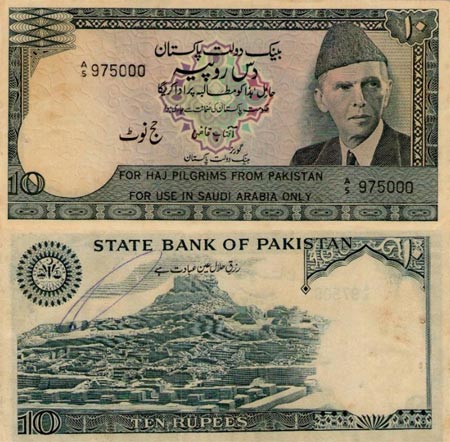
With this pilgrimage in mind, Pakistan has printed 10 and 100 Rupee banknotes up until 1994 that were to be used by pilgrims along the route of their pilgrimage. I am not quite sure what the root intent was, but in 1994 these banknotes were discontinued and all such notes that were on hand were destroyed. I think that were is at least one other country which issued similar Haj pilgrimage notes, but I can’t recall what country it is ...
Original was posted on RealBanknotes.com Blog
|
Gennaio 4
2011
|
What's wrong with this Chinese banknote of 100 yuan?

Answer is under cut Read more...
|
Novembre 29
2010
|
What is the significance of a SHEET of dollar bills? I have an uncirculated, uncut sheet of dollar bills, 16 in all.
The confusing thing is the bills all have the same serial number??? Has anyone ever seen this before?
My mother-in-law got them from her bank president (pers friend) as a gift. He told her hang onto them.
|
Novembre 3
2010
|

American dollars are burned during a ceremony in honor of deceased ancestors in the old district of Hanoi, Vietnam.
|
Giugno 22
2010
|
During WWII, with fears that Japan would overrun Hawaii, the US decided to issue the $1, $5, $10 and $20 Emergency Federal Reserve Notes with the word "HAWAII" overprinted on the front and back to make each note distinctive enough so that they would know if large amounts were being used to fund the enemy war effort:
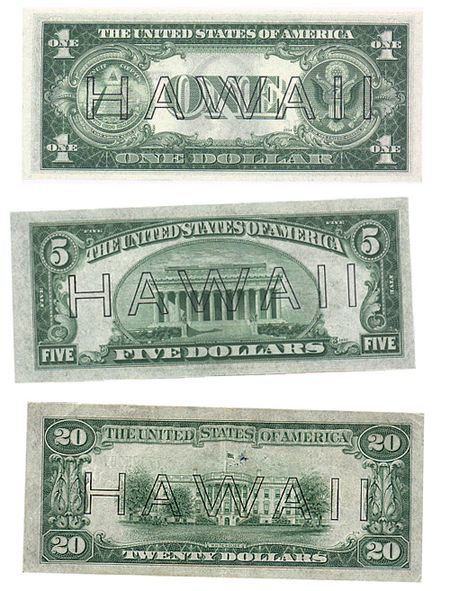
|
Giugno 18
2010
|
"Mason" word, it is just another masonic symbolism on the dollar bill:

The ritual of Freemasonry is well endowed with symbols – things familiar that could convey a hidden meaning to those initiated. Man uses signs, pictures, emblems and words etc to convey ideas from individual to individual and some of the aforementioned lend themselves to symbolism more than others. This was especially so in the Age of Enlightenment during the 18th century.
|
Giugno 10
2010
|
I was quite curious about this whole ‘German Vampire Banknote’ thing, so I decided to do some research. I found that picks 70, 71, and 72, which feature a male portrait by Albrecht Durer are all considered to be German Vampire Banknotes. When looking at the picture some people see a vampire sucking on the neck of the young man. This has been interpreted by some as a representation of the French sucking the blood of the Germans through the reparations of World War I. I have tried to show this in the image below:
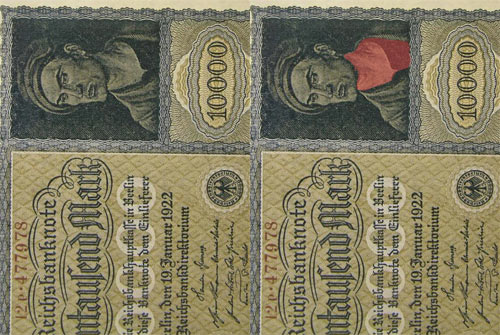
German Vampire Note: 10000 Marks from 1922 (p72)
Source: RealBanknotes Paper Money Collecting
|
Maggio 13
2010
|
Britain axes 500 euro note over organized crime fears. Such is its popularity among criminals, the 500 euro note has earned itself a nickname - the Bin Laden. It is so called because you know it's out there, you know what it looks like, it moves around a lot but no-one ever sees it. But the note's days as a favorite for organized crime gangs, terrorists and money launderers may be numbered after it was withdrawn from circulation in Britain.
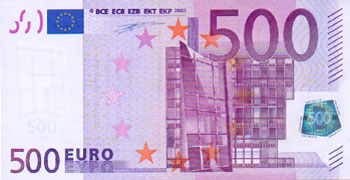
The Serious Organised Crime Agency (Soca) said there there was 'no credible legitimate use' for the notes - which are worth £426 each. UK wholesalers agreed to stop selling the distinctive pink and purple note last month after Soca investigators found nine out of ten were used for illegal activities.
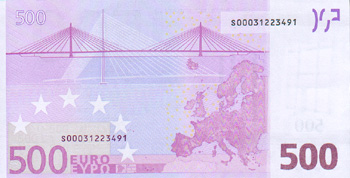
The move is likely to heap pressure on the European Central Bank to withdraw the note from circulation entirely. It remains legal tender in the UK and there are fears British criminals will now simply source their 500 euro notes on the continent, or turn to the smaller value 200 euro note which is worth £170.
Before the ban came into force, Soca found one backstreet money supplier which imported more than £4million worth of the notes in a single year - more than the number used by major high street banks.
Big money: the world's largest denominations
- Euro - 500 note, Value in Pounds £426
- US $ 100 note £67.19
- Chinese Yuan 100 note = £9.83
- Australian Dollar 100 note = £60.20
- Canadian Dollar 100 note = £65.99
- South African Rand 200 note = £17.95
- Swiss Franc 1,000 note = £609.86
- Singapore Dollar 1,000 note = £487.18
- Russian Ruble 5,000 note = £112.31
- Indian Rupee 1,000 note = £14.94
|
Aprile 13
2010
|

If you're out by the toll booth and there's no light in your bag, car or the rat-hole toll booth then you may well end up overpaying or underpaying and embarrassing yourself in the process. So we have this awesome concept from China that has currency notes that glow. How cool is that? If will make Uncle Scrooge's room look like a bio-waste plant with all the glowing green.


Notes that emit a soft glow, just enough to ensure you hand out the correct note; nothing more nothing less.
So will we see luminous money in the future? Never know. I feel that we're already in the future.
|
Marzo 18
2010
|
The Scots have a colorful (and tragic) history of fighting the domination of the English that ended, more or less, with the butchery that was the Battle of Culloden (16 April 1746), in which tired, hungry, and somewhat unenthusiastic Scotsmen armed with swords, at best, took on England's best, armed with bayonet-fixed firearms. So it was with some surprise that upon giving a 20 pound note with the likeness of the Queen on it to a cashier for my first purchase in Glasgow's Central train station (a local map book), the 10 pound note I got as change looked like this:
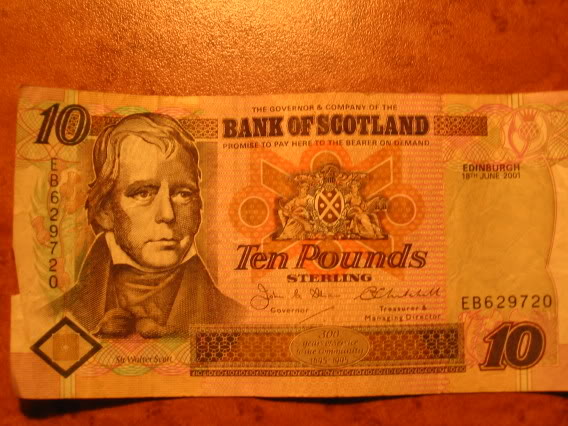
When the typical 10 pound note I see in London looks like this: Read more...
|
|